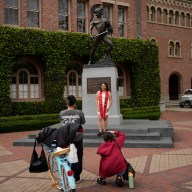
Insert a shovel anywhere within Israel, and you’ll find a trace of one, if not each, of its past reigning civilizations. Or just visit Caesarea, on the Mediterranean Sea, north of Tel Aviv.
Herod, the king of Judea — yes, that Herod — built the city about 25 years before Jesus was born in the area. Designed as an appeasement to Rome and a show of its power, Herod constructed the first man-made port in history.
“It was an artificial harbor in an open sea,” exclaims Jacob Sharvit, marine archaeologist with the Israel Antiquities Authority, whose excitement for the site is still palpable. “They understood everything about the wind, the currents. If we were building it today, we’d use different materials, but do it the same way.”
Visitors don wetsuits and, with a water-proof map, explore the ruins — the original breakwater, a Roman shipwreck, Byzantine anchors — in an underwater museum. There’s much to see on land as well, including an amphitheater, hippodrome and bathhouse and the foundation of an imposing palace that once jutted into the crashing Mediterranean waves.
After Herod’s death, the city became the local Roman capital (Pontius Pilate was prefect) until the year 640, when it was taken by Arabs, who ruled until the Crusaders came in 1101. The Crusaders occupied the city on and off until it was taken by the Mamluks in 1261, who left it in ruins. Bosnian Muslim refugees moved there in 1878, later fleeing during the war of 1948. Each community left its signature in city walls, repaired breakwaters and houses of worship.
And that’s just Caesarea proper. Adjacent to the city’s north side are remains of a Phoenician settlement predating Herod. And nearby — 100 meters off shore and 11 to 12 below sea level — marine archaeologists are uncovering a 10,000- to 11,000-year-old Neolithic settlement. Sharvit explains that the work is brand new and has not been published yet, adding with enthusiasm, “It’s like a puzzle: you find pieces, and try to understand the whole picture. I love working in the sea.”
Archaeological must-sees
Beit She’arim: Inside hollowed-out limestone caves are hundreds of beautifully carved and inscribed sarcophagi that once held the remains of the 2,200- to 2,400-year-old rich and famous.
Masada: In the year 70, about 1,000 fleeing Jews took refuge in a palace in the sky, an abandoned settlement atop a high and isolated desert mesa. Romans soldiers built a ramp to reach them — the Jews killed one another and themselves rather than surrender.
Hezekiah’s Tunnel: Almost 2,800 years ago, to stop invading armies from cutting off Jerusalem’s water supply, workers carved a tunnel to siphon the Gihon Spring’s water under the city walls. You can walk its dark, narrow and still-gushing path.
















